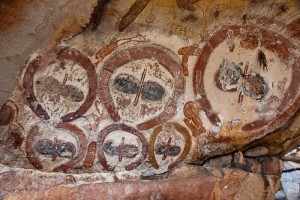SUNDAY, 2 JANUARY 2011
Recently, a study of 80 of these paintings by Professor Pettigrew of the University of Queensland has shown that the paintings retain their vibrancy because the paint has been replaced by biofilms of pigmented microorganisms. A mulberry colour is preserved by a black fungus, probably of the species Chaetothyriales; a cherry colour is maintained by a red organism, probably a type of cyanobacteria.In many other cases biofilms have destroyed rather than preserved paintings. However, the research proposes that the biofilms have preserved the Bradshaw paintings for the following reasons. Firstly, the fungus is very conservative and only the painted regions offer a suitable environment to live and reproduce. There may also be certain nutrients in the original paint that started the colonies, allowing a stable mutualism of fungi and cyanobacteria to survive. Or, the original paint may have altered the rock to create an environment that is more favourable for the microorganisms.
Further studies are planned in which the DNA of these interesting organisms is examined to see when these strains diverged from other similar forms. This should yield more information as to how the microorganisms help to preserve the paintings, as well as allowing the rock art to be dated more accurately.
More information and photographs can be found at the Bradshaw Foundation website.
Written by Wendy Mak

